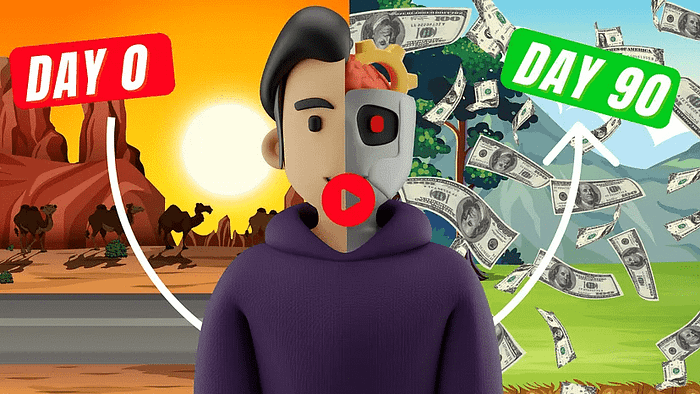How I Grew My Startup to $500k Using Google Ads: A Step-by-Step Success Story
Breaking through the digital marketing ceiling, I transformed a modest startup into a thriving $500,000 enterprise using Google Ads as my primary growth engine. The journey wasn’t just about increasing revenue – it was about mastering the art of sustainable profitability in the ever-competitive e-commerce landscape. Through meticulous optimization of Google Ads campaigns and a fundamental shift in business strategy, I discovered the delicate balance between explosive growth and sustainable profitability.
We strongly recommend that you check out our guide on how to take advantage of AI in today’s passive income economy.
Table of Contents
The Mindset Shift That Changed Everything
One critical revelation emerged when analyzing my Google Ads performance: the pursuit of revenue alone wasn’t enough. Initially, like many entrepreneurs, I chased impressive top-line numbers, celebrating months where sales reached $142,000 or even $172,000. However, these seemingly successful periods often masked a concerning reality – our net profit margins were hovering around a mere 10%. The wake-up call came when I realized that high revenue didn’t automatically translate to sustainable business growth. Managing large order volumes strained our customer service team, increased refund requests, and created operational bottlenecks that threatened to derail our entire operation. This revelation forced me to pivot my Google Ads strategy entirely.
The transition wasn’t easy. It required completely restructuring our approach to Google Ads, moving away from vanity metrics and focusing intensely on profitability. Each campaign decision became a calculated move, weighing the potential revenue against operational costs, customer service requirements, and long-term sustainability. This shift in perspective led to a dramatic improvement in our overall business health, with profit margins climbing steadily as we optimized our operations.
The Financial Analysis That Reshaped Our Strategy
Diving deep into our expense structure revealed hidden inefficiencies within our Google Ads campaigns. The breakthrough came when I started treating each campaign as its own profit center, meticulously tracking not just the return on ad spend (ROAS) but also the true profit contribution after accounting for all operational costs. This granular analysis exposed campaigns that appeared successful on the surface but were actually draining our resources.
I developed a comprehensive tracking system that considered not just advertising costs, but also product costs, shipping expenses, customer service overhead, and potential return rates. This holistic approach to campaign evaluation transformed our decision-making process. Campaigns that previously seemed profitable were often revealed to be barely breaking even when all costs were considered. This insight led to a complete restructuring of our Google Ads strategy, focusing on campaigns that delivered true profitability rather than just high revenue numbers.
Understanding Algorithm Evolution and Market Dynamics
Google Ads’ algorithm constantly evolves, adapting to market changes, new competitors, and shifting consumer behaviors. This dynamic nature meant that previously successful campaigns could suddenly become unprofitable. I developed a systematic approach to monitor and adjust campaigns, ensuring consistent performance even as market conditions changed. Understanding these algorithmic changes became crucial to maintaining our high performance.
Through extensive testing and analysis, I discovered patterns in how the algorithm responded to different types of campaign adjustments. This led to the development of a proactive optimization strategy that allowed us to stay ahead of market changes rather than simply reacting to them. By closely monitoring key performance indicators and market trends, we could anticipate and adapt to changes before they significantly impacted our performance.
The Secret Behind Consistent 7X ROAS
Success in Google Ads isn’t about finding a single magical campaign setting – it’s about orchestrating multiple elements to work in harmony. My breakthrough came from optimizing three core areas: visual appeal, technical optimization, and backend systems. Each element played a crucial role in achieving and maintaining a 7X return on ad spend. This comprehensive approach ensured that every aspect of our campaigns was working together to maximize performance.
The real secret lay in understanding how these elements interacted with each other. A change in one area often had ripple effects throughout the entire system. For example, improving our product imagery not only increased click-through rates but also led to higher conversion rates and better quality scores, creating a virtuous cycle of improvement.
Visual Optimization Strategies
Product imagery became a cornerstone of our success with Google Ads. Instead of using standard white-background product photos, we experimented with lifestyle images that captured attention and dramatically improved click-through rates. This innovation reduced our cost per click while maintaining conversion quality. The transformation began when we noticed competitors all using similar, sterile product images. By breaking this pattern with dynamic, contextual photographs, we immediately stood out in the crowded Google Shopping landscape.
Our image optimization strategy went beyond just using lifestyle photos. We developed a systematic approach to A/B testing different image styles, angles, and contexts. For instance, when selling home products, we discovered that images showing the product in use in a lived-in environment consistently outperformed pristine, staged shots. This seemingly simple change led to a 32% increase in click-through rates and a corresponding decrease in cost per acquisition.
The Power of Technical SEO Integration
Understanding that Google Ads works synergistically with SEO principles transformed our approach. By optimizing product listings with robust keyword research and strategic meta descriptions, we helped Google’s algorithm better understand our offerings and target the right audience more efficiently. This integration between SEO and Google Ads became a powerful multiplier for our campaign performance.
The technical optimization went far beyond basic keyword inclusion. We developed a comprehensive system for product page optimization that included structured data markup, enhanced product descriptions, and carefully crafted meta information. This technical foundation made it easier for Google’s algorithm to understand and categorize our products, leading to more relevant ad placements and higher quality scores.
Advanced Campaign Segmentation Strategies
Our breakthrough in campaign management came from developing a sophisticated segmentation strategy. Rather than running generic campaigns, we created highly targeted segments based on user behavior, product categories, and performance metrics. This granular approach allowed us to allocate budgets more effectively and optimize each segment independently.
The segmentation strategy evolved into a three-tier system: exploration, optimization, and scaling. Each product category moved through these phases based on performance data. This systematic approach prevented us from prematurely scaling unprofitable segments while ensuring we didn’t miss opportunities to expand successful ones. The key was maintaining strict performance thresholds at each level before advancing products to the next tier.
Backend Systems and Customer Journey Optimization
The real magic happened when we started optimizing the entire customer journey, not just the initial ad interaction. By implementing sophisticated email marketing sequences, retargeting campaigns, and post-purchase follow-ups, we created multiple touchpoints that reinforced our brand message and encouraged repeat purchases. This comprehensive approach significantly improved our customer lifetime value metrics.
Our email marketing sequences were particularly effective at recovering abandoned carts and nurturing long-term customer relationships. We developed a series of automated workflows that provided value at each stage of the customer journey, from initial interest to post-purchase support. This backend optimization contributed significantly to our overall ROAS by increasing customer retention and encouraging repeat purchases.
Scaling Methodology and Growth Systems
The path to $500,000 in sales required developing scalable systems that could maintain profitability even as we expanded. We created a detailed scaling framework that considered multiple factors: inventory management, customer service capacity, marketing budget allocation, and operational efficiency. This systematic approach allowed us to grow without sacrificing quality or profitability.
Each scaling decision was backed by data and carefully monitored for sustainability. We developed early warning systems to identify potential issues before they became problems, allowing us to maintain stable growth even during rapid expansion periods. This proactive approach to scaling became crucial in maintaining our high ROAS as we grew.
Long-term Success and Future Growth
Looking ahead, the principles that drove our success with Google Ads remain relevant, but we continue to evolve our strategies. The key lies in maintaining a balance between growth and profitability while continuously adapting to market changes and algorithmic updates. Our focus has shifted from pure growth to building sustainable, long-term competitive advantages.
The journey to $500,000 in sales taught us valuable lessons about sustainable growth in the e-commerce space. Success isn’t just about mastering Google Ads – it’s about building a comprehensive business system that can consistently deliver value to customers while maintaining healthy profit margins. This holistic approach to business growth continues to drive our success today.
Conclusion
The path to growing a business from zero to $500,000 using Google Ads requires more than just technical knowledge – it demands a comprehensive understanding of business operations, customer psychology, and market dynamics. By focusing on sustainable growth rather than short-term gains, we built a foundation for long-term success that continues to deliver results.
For e-commerce businesses looking to achieve similar results, the key lies in developing systematic approaches to growth while maintaining strict profitability standards. Success with Google Ads isn’t about finding quick wins – it’s about building sustainable systems that can deliver consistent results over time. With patience, dedication, and a data-driven approach, similar results are achievable for businesses willing to invest in long-term success.
Remember, the journey to $500,000 in sales is just the beginning. By maintaining focus on profitability, customer satisfaction, and operational excellence, there’s no limit to what can be achieved with Google Ads as a primary growth channel.

We strongly recommend that you check out our guide on how to take advantage of AI in today’s passive income economy.




